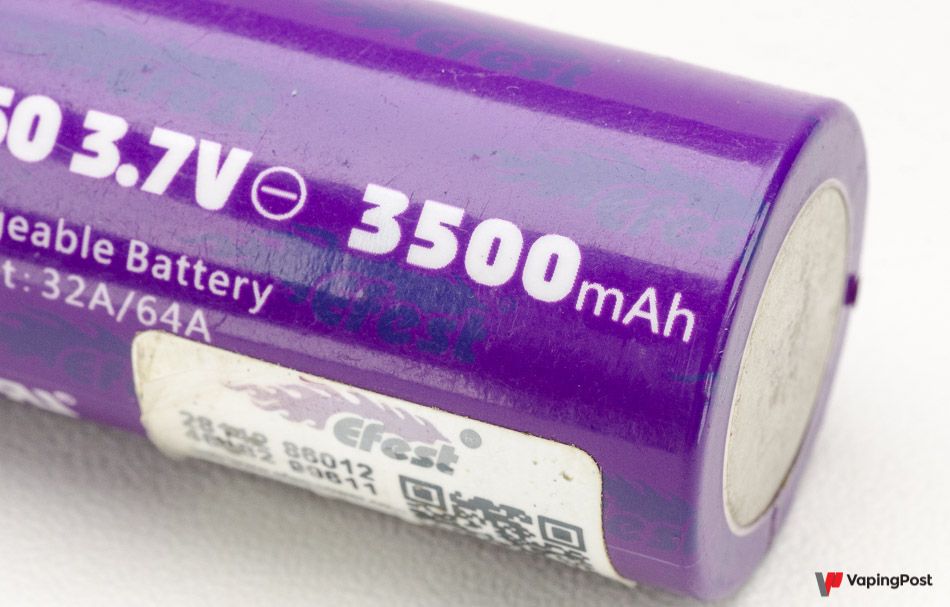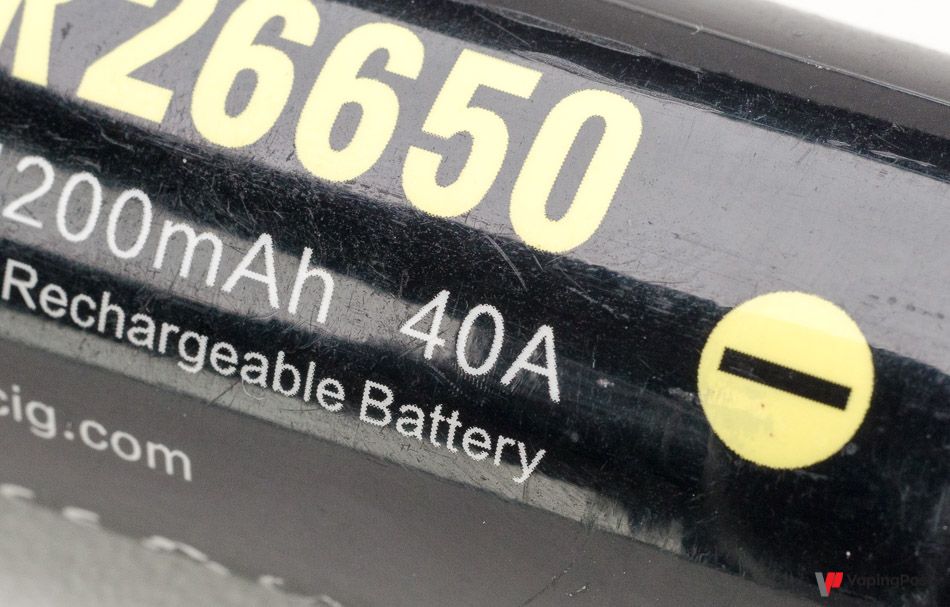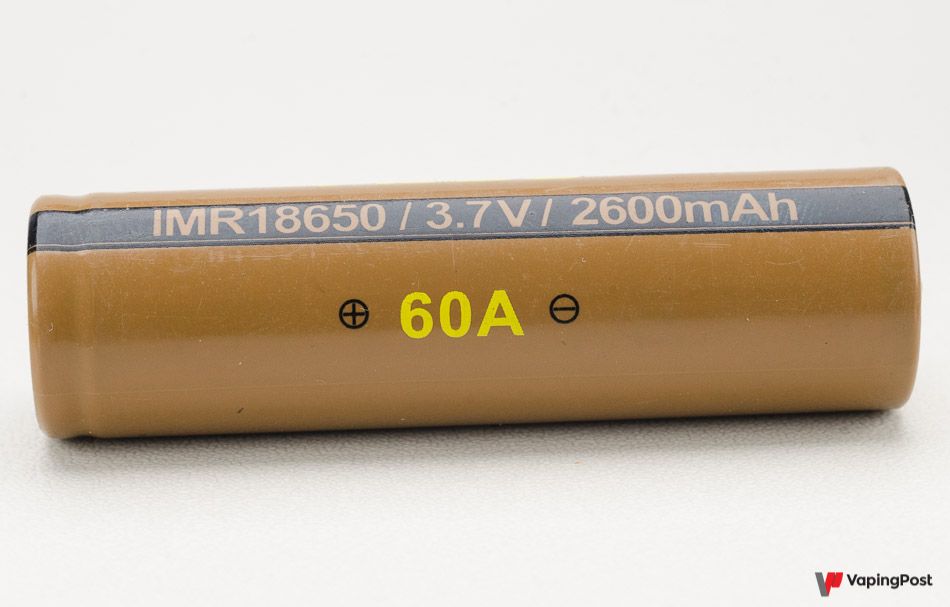How do you choose a battery?
To choose a battery, check that it can withstand the power needed and that it offers a good battery life. Two simple criteria and two characteristics which are often misinterpreted. Below we shed light on what is actually meant by the capacity and MDC in batteries.
Key characteristics
You could write books, or even whole libraries, on batteries. Between the extremely simplified version and the PhD thesis, it is useful to know the main characteristics to remember and what they actually mean, especially given the considerable confusion arising around this topic.
We will not discuss battery size here. If your box is supposed to operate with an 18650, you need an 18650. The first two digits indicate the battery diameter in millimetres, the next two its length, also in millimetres, and the “0” at the end indicates that it is round. Therefore, an 18650 is a cylindrical battery 18 mm in diameter and 65 mm in length.
As such, we will now detail the two key characteristics, the capacity and the maximum discharge current, also known as CDM or “amperage”. In an another article, we discuss more specialised specifications, which are useful if you want to optimise your choice, such as the internal resistance, voltage sag, chemistry, and rated voltage.
Capacity (mAh)

The capacity, which is expressed in milliamperes per hour (mAh), indicates the battery life. It represents the number of milliamperes that the battery is capable of delivering in one hour. For example, a 3000 mAh battery can deliver 3000 milliamperes for one hour. Therefore, if it is used at 1500 milliamperes (mA), half that amount, it will last for 2 hours (double).
The capacity is thus a ratio between the current drawn from the battery and the time that it will last before it is fully discharged. A battery will last for considerably less time if you vape at 100 W than if you vape at 10 W. It contains the same amount of electricity initially, but, logically, the more each puff consumes, the fewer the puffs you will get before having to charge again. In this way, the capacity serves as a point of comparison between two different batteries rather than an absolute indication providing a precise estimation of the battery life in each individual case.
To measure the capacity of a battery, charge it fully (4.2 V), and discharge it on a test bench with low constant current, to reduce the voltage sag effect, until the voltage drops to 2.8 V. Measure the time taken for the battery to discharge, and apply a simple rule of 3 to determine how many milliamperes are output per hour. For example, if it lasted for 30 hours at 100 mAh, it has a capacity of 3000 mAh (30 x 100).
Manufacturers’ technical data sheets often specify two values: the minimum or guaranteed capacity, and the typical or rated capacity. The first value is a minimum, the second an average measured on production, slightly above the minimum value, and generally selected as the commercial value.
Maximum discharge current (MDC)
This is the key characteristic. The maximum discharge current, or MDC, indicates the maximum current that can be output by the battery. Why is this key? Because boxes are claiming increasingly high available powers, because vaping is tending towards increasing power levels, and batteries need to be able to handle delivering such power levels.
Continuous MDC

Therefore, the MDC is the current that you must not exceed with a battery, and hence the maximum power that it can deliver. When you put it like that, it leaves scope for countless interpretations that you will come across here and there, more or less close to reality.
The MDC is not a safety limit per se, but it is often interpreted as such. To measure it, continuously discharge the battery at a given current, and measure its operating temperature. The higher the current drawn from the battery, the higher the operating temperature, on account of its internal resistance. The MDC is the current that can be delivered continuously by the battery, without its temperature exceeding 80°C.
Why 80°C? Because that is the maximum temperature that batteries can withstand without being degraded and dropping in performance. Therefore, the MDC is not a safety limit per se; for that, you would have to perform the measurement until the battery reaches a higher, critical, temperature of approximately 100°C. There is no need to get all fired up all the same. Firstly, the safety limit is often close to the MDC, just a few amperes more, and, secondly, because it would be reckless to use a battery at its explosive limit! The MDC is not a safety limit when measured, but it is one when in use, and exceeding it quickly increases the risk of running into big trouble.
Pulse, max MDC, and other nonsense

The sole value specified in manufacturers’ technical data sheets for the MDC is the continuous measurement mentioned above. The battery is tested continuously, i.e. at a constant current throughout the discharging process.
The only problem is that you don’t vape continuously! You take a puff, stop, take another one, etc. Therefore, the battery has the time to cool between breaks, giving rise to the pulse MDC concept. As the battery has the time to cool between puffs, its temperature is not so quick to rise, making it possible to use it above the continuous MDC without exceeding 80°C! Yippee!
In theory, this reasoning makes sense. In practice, let’s be clear, the pulse MDC is a monumental aberration, nonsensical, and an excellent way to make a mess of things.
Firstly, to truly be able to refer to the pulse MDC, the pulse itself needs to be standardised: a pulse of what duration, with how many breaks between pulses, at what temperature, etc. As it is, it is like talking about a speed in thingamajigs per hour, without defining what a thingamajig is. Therefore, the values claimed are useless, as it is not known what they actually measure, they could be… anything.
Secondly, at very high currents, the battery sustains internal damage before its external temperature exceeds 80°C. Pulses create localised hot spots in the battery, where it will be damaged. The temperature rises locally very quickly at high currents, without the entire battery having the time to reach 80°C, but the battery is well and truly damaged.
Finally, for anyone who might still be in doubt, battery tests to determine their MDC are performed in the open air, where they cool normally. In a box, they are confined in a very compact space with very little ventilation. The temperature rises much more quickly, and the battery cools more slowly. The principle is the same as that of an oven: when the door is open, the temperature is considerably lower than with the door closed. The fact that the battery is not being used continuously compensates for this confinement, but the room for manoeuvre is already used up in respect of pulse-based use!

Original battery manufacturers solely specify the continuous MDC, which is the only MDC worth noting. However, pulse MDC values are widely used by “rewrappers”, i.e. distribution brands that limit themselves to repackaging original batteries in order to potentially exaggerate their technical characteristics. This is out-and-out marketing, and we would like to point out the need for a good knowledge of the chemical properties of the batteries that you use with your vaping set-up. A battery claiming to be 40 A will sell better than a 20 A battery, which is reason enough to practice one-upmanship, but which can sometimes be detrimental for the user, even to the point of endangering them. These values, whose purpose is above all commercial, are either specified on their own, or preceded by the terms “max”, “pulse” or another meaningless terms. We discuss this in detail in our article on battery brands.
The current limits for 18650 batteries are 10 A for 3500 mAh models, 20 A for 3000 mAh models, 25 A for 2500 mAh models (Sony VTC5A), and 30 A for 1500 mAh models. There are no 18650 batteries with an MDC of 40 A on the market, and no 3000 mAh models offering 25 A, despite what rewrappers might have you believe.
A small detail to counter those remarking that some manufacturers specify pulse MDC values. The most classic example is Sony with the VTC 6, specifying 80 A for 6 seconds in its technical data sheet. This is not an operating value, but very explicitly an indication for the safety circuits of the packs in which 18650 batteries are supposed to be used (section 8.2.4.3, “Over current protective circuit”). The battery will not explode if the safety circuit handles the situation, but it is fit for recycling immediately afterwards. It may seem so at first glance, but this information is not relevant to the MDC. Moreover, the independent tests conducted by Mooch on the VTC6, which are the reference in the field, indicate, for the VTC6, a hazardous operating temperature of 105°C with apparently reasonable 5-second pulses and 30-second breaks at… 60 A, which is some way away from 80 A.
- Besides the choice of a battery model, some brands are worth recommending and others should be avoided. For this reason, we have prepared a table for a market shared between manufacturers and “rewrappers” to determine which battery brand you should choose.
To find out more…
Batteries are a huge topic; we have written a series of articles examining the question.
- As straightforward as it might be, battery charging requires some pointers and was well worth devoting an article to help you do so safely and effectively.
- Buying the right battery is good, but keeping it longer is even better! For this reason, we have compiled a comprehensive tutorial on extending the service life of your batteries.
- However, a drop in battery performances, a battery impact or breach of the protective sleeve is bound to happen eventually. It is important to know when to replace a battery and how to dispose of it.
- And if you want to understand how to optimise your battery choice and use, our article on battery specifications goes into more detail on the concepts of internal resistance, voltage sag, rated voltage, and provides details on the different chemistries.
- Finally, if you are one of the many people who believe the serial / parallel battery configuration or set-up resistance to have some importance in terms of battery life or the current drawn from batteries in an electronic box, our article on choosing batteries in an electronic box is for you.
- On another note, an article on e-cigarette battery explosions. As the media feast on these stories, despite them being extremely rare, we thought it was important to review this explosive topic to understand it, and above all prevent it from happening to you.
Don’t forget!
- Never use a battery beyond its specifications, both for battery life and your safety.
- Always carry batteries in suitable protection; most of the rare accidents that occur are linked with transporting unprotected batteries.
- Only use batteries that are in perfect condition, free from scratches or impacts.
- Never throw a battery away, place it in a specific recycling container.













